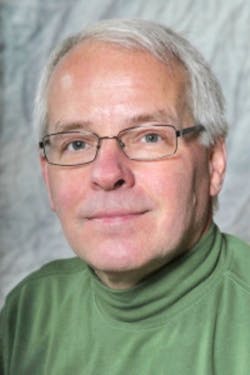ITC plenary keynote looks at testing beyond the green light
Fort Worth, TX. After two days of tutorials, ITC formally got underway Tuesday morning with a plenary session hosted by ITC General Chair Li-C. Wang. The highlight of the event was the keynote address by Robert Klosterboer, executive vice president and general manager of the Analog Solutions Group at ON Semiconductor, who discussed “testing beyond the green light.”
Before Klosterboer’s talk, Wang summarized this year’s ITC, with a focus on machine learning, automotive technology, and security, covered in 14 technical sessions. The plenary session also provided an opportunity for award presentations recognizing papers and professional accomplishments.
Wang also summarized two related events held earlier this year. ITC India 2017 held July 9-11; it drew more than 300 attendees plus seven exhibiting companies. The event included six technical sessions and six tutorials. ITC Asia 2017, held September 13-15 in Taiwan. It drew more than 200 technical attendees and 22 exhibitors; it was collocated with SEMICON Taiwan, which drew more than 30,000 attendees.
Program Chair Peter Maxwell followed Wang to the stage, noting that this week’s ITC is featuring 14 paper sessions with 43 accepted papers, representing an acceptance rate of about 30%.
Maxwell presented the 2016 Ned Kornfield best-paper award for “Power supply impedance emulation to eliminate overkills and underkills due to the impedance difference between ATE and the customer board,” by Toru Nakura and Naoki Terao of the University of Tokyo and Masahiro Ishida of Advantest. He also presented an award for a 2007 paper that continues to resonate 10 years later; the winning paper is “A scan-island based design enabling pre-bond testability in die-stacked microprocessors,” by Dean L. Lewis and Hsien Hsin S. Lee.
Next up, TTTC president Yervant Zorian took the stage to present several awards. First, he presented a lifetime contribution award to Jacob A. Abraham, a professor at UT Austin and the author of more than 525 technical papers. Kuen-Jong Lee of National Cheng-Kung University was named an IEEE Fellow for work on low-cost testing of digital VLSI circuits. The Bob Madge Innovation Award went to Li-C. Wang for work involving statistical methods in test and machine learning for test and EDA. The G.W. Gordon student service award went to Anastasia Hahanova of Kharkov National University of Radio Electronics. And finally, Zorian announced that TTTC Vice Chair Cecilia Metra of the University of Bologna is the 2018 IEEE President-Elect.
Klosterboer then took the stage and described the dark ages of test, brightened only by a red or green light. The pass/fail results of those days have given way to a test environment driven by machine learning and artificial intelligence. But challenges remain in the pursuit of zero-defect devices for automotive ADAS systems and digital medicine, for example. He also commented on “digital dependency”—studies have shown that users’ blood pressure rises if their cellphone batteries go dead.
Issues to address, he said, include capacity optimization, yield and factory/process improvements, mass parallelism, and temperature-test elimination. We have used temperature testing as a bit of a crutch, he said, when we have the data to eliminate it in a lot of situations. Still other issues include security, die-level traceability, anticounterfeiting, and rad-hard by design. The key to meeting the challenges, he said, is really understanding the data we have.
He recounted from the dark ages the test of a part used in a typewriter. The test engineers simply couldn’t mimic on ATE the conditions that cause an actual bad part to test bad. The solution was to plug the parts into a typewriter and have a typist type a couple of words. Such an approach is not viable today, he said, because of the volumes we have.
He then addressed big data and the uses to which we put it. An instrumented jet engine, he said, can generate a terabyte of data every 20 minutes. Can we effectively use such quantities of data? In the old days, a device might have gotten the green light, but how close to failing had it been? Perhaps it was from a bad neighborhood. Today we have the date to make such decisions, if we can analyze it properly. Of course, he said, our pass/fail threshold will change based on the end application: a flight controller, for example, or a gadget to hand out free at a trade show.
He called for integration of metrology and test databases, for example, as well as for more support from EDA companies. He further cautioned that as the industry makes more use of big data and machine learning, it’s important to make sure the big data is good data. AI is only as good as the data fed into it, he concluded.
About the Author

Rick Nelson
Contributing Editor
Rick is currently Contributing Technical Editor. He was Executive Editor for EE in 2011-2018. Previously he served on several publications, including EDN and Vision Systems Design, and has received awards for signed editorials from the American Society of Business Publication Editors. He began as a design engineer at General Electric and Litton Industries and earned a BSEE degree from Penn State.
